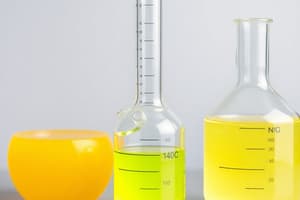Podcast
Questions and Answers
Which of the following represents a monobasic acid?
Which of the following represents a monobasic acid?
- HCl (correct)
- H3PO4
- H2SO4
- HNO3
Sulfuric acid is classified as a weak acid.
Sulfuric acid is classified as a weak acid.
False (B)
What ion do bases produce when dissolved in water?
What ion do bases produce when dissolved in water?
OH-
A _____ acid is one that only slightly dissociates in water to give hydrogen ions.
A _____ acid is one that only slightly dissociates in water to give hydrogen ions.
Match the following acids with the correct type based on their dissociation:
Match the following acids with the correct type based on their dissociation:
Which of the following defines a strong base?
Which of the following defines a strong base?
Hydronium ion (H3O+) can exist independently in water.
Hydronium ion (H3O+) can exist independently in water.
According to the Bronsted-Lowry theory, an acid is defined as a _____ donor.
According to the Bronsted-Lowry theory, an acid is defined as a _____ donor.
What is a Bronsted-Lowry base?
What is a Bronsted-Lowry base?
A strong acid is a poor proton donor.
A strong acid is a poor proton donor.
What do we call a substance that can act as both an acid and a base?
What do we call a substance that can act as both an acid and a base?
H2O can act as a _____ when it accepts a proton.
H2O can act as a _____ when it accepts a proton.
Which of the following describes the Arrhenius Theory?
Which of the following describes the Arrhenius Theory?
Match the following terms with their definitions:
Match the following terms with their definitions:
Every acid has a conjugate base.
Every acid has a conjugate base.
What is the conjugate base of HC2O4-?
What is the conjugate base of HC2O4-?
What is the main product when an acid reacts with a base?
What is the main product when an acid reacts with a base?
A salt is formed when a metal ion replaces the hydrogen ion in an acid.
A salt is formed when a metal ion replaces the hydrogen ion in an acid.
What base is commonly used in Gaviscon to neutralize stomach acid?
What base is commonly used in Gaviscon to neutralize stomach acid?
Calcium oxide reacts with water to form ______.
Calcium oxide reacts with water to form ______.
Which reaction represents the neutralization of hydrochloric acid?
Which reaction represents the neutralization of hydrochloric acid?
What is formed when sulfuric acid reacts with limestone?
What is formed when sulfuric acid reacts with limestone?
Match the acid with its corresponding reaction product.
Match the acid with its corresponding reaction product.
To neutralize the acidic soil, farmers apply ______.
To neutralize the acidic soil, farmers apply ______.
Flashcards
Arrhenius Acid
Arrhenius Acid
A substance that releases H+ ions when dissolved in water.
Strong Acid
Strong Acid
An acid that almost completely breaks apart (dissociates) into ions in water.
Weak Acid
Weak Acid
An acid that only slightly breaks apart (dissociates) into ions in water.
Arrhenius Base
Arrhenius Base
Signup and view all the flashcards
Strong Base
Strong Base
Signup and view all the flashcards
Weak Base
Weak Base
Signup and view all the flashcards
Hydronium ion
Hydronium ion
Signup and view all the flashcards
Bronsted-Lowry Acid
Bronsted-Lowry Acid
Signup and view all the flashcards
Bronsted-Lowry Base
Bronsted-Lowry Base
Signup and view all the flashcards
Amphoteric Substance
Amphoteric Substance
Signup and view all the flashcards
Conjugate Acid
Conjugate Acid
Signup and view all the flashcards
Conjugate Base
Conjugate Base
Signup and view all the flashcards
Neutralization Reaction
Neutralization Reaction
Signup and view all the flashcards
Salt Formation
Salt Formation
Signup and view all the flashcards
Uses of Neutralization
Uses of Neutralization
Signup and view all the flashcards
Heartburn Relief
Heartburn Relief
Signup and view all the flashcards
Soil Acidity
Soil Acidity
Signup and view all the flashcards
Acid Rain Mitigation
Acid Rain Mitigation
Signup and view all the flashcards
Study Notes
Arrhenius Theory of Acids and Bases
- Acid: A substance that dissociates in water to produce H+ ions
- Example: HCl → H+ + Cl-
- Monobasic acid: Dissociates to give one H+ ion
- Dibasic acid: Dissociates to give two H+ ions
- Tribasic acid: Dissociates to give three H+ ions
- Examples:
- HCl (monobasic)
- H₂SO₄ (dibasic)
- H₃PO₄ (tribasic)
- Strong acid: A substance that almost completely dissociates in water to give hydrogen ions
- Weak acid: A substance that only slightly dissociates in water to give hydrogen ions
- Base: A substance that dissociates in water to produce OH⁻ ions
- Example: NaOH → Na⁺ + OH⁻
- Strong Base: A substance that almost completely dissociates in water to give hydroxide ions
Shortcomings of the Arrhenius Theory
- Limited to reactions in water
- Not all acid-base reactions need or involve OH- ions
Brønsted-Lowry Theory of Acids and Bases
- Acid: A proton donor
- Base: A proton acceptor
- Example: HCl + H₂O → H₃O⁺ + Cl⁻ (HCl donates a proton, H₂O accepts a proton)
- Amphoteric substance: A substance that can act as both an acid and a base
Definitions
- Strong Acid: A good proton donor
- Weak Acid: A poor proton donor
- Strong Base: A good proton acceptor
- Weak Base: A poor proton acceptor
Comparing Arrhenius and Brønsted-Lowry theories
- Arrhenius: Limited to reactions in water; limited to bases that produce OH⁻ ions; does not consider hydronium ions; cannot explain substances acting as both acid and base
- Brønsted-Lowry: Not limited to water; not limited to bases that produce OH⁻ ions; considers hydronium ions; can explain substances acting as both acid and base
Conjugate Acid-Base Pairs
- Conjugate acid: An acid formed when a base accepts a proton
- Conjugate base: A base formed when an acid loses a proton
- Example: CH₃COOH → CH₃COO⁻ + H⁺ (CH₃COOH is the acid and CH₃COO⁻ is the conjugate base)
Neutralization
- Definition: The reaction between an acid and a base to form a salt and water
- Example: HCl + NaOH → NaCl + H₂O
Uses of Neutralization
- Medicine: Neutralizing excess stomach acid
- Agriculture: Neutralizing soil acidity
- Environmental protection: Neutralizing acid rain effects
Exam Questions and Concepts
- Strong vs. Weak acid: Strong acids completely dissociate, weak acids only partially.
- Conjugate bases: A strong acid will have a weak conjugate base; a weak acid will have a strong conjugate base.
- Dissociation in water: Equations describing the behavior of acids, conjugate bases of acids, and bases acting in water.
Studying That Suits You
Use AI to generate personalized quizzes and flashcards to suit your learning preferences.




